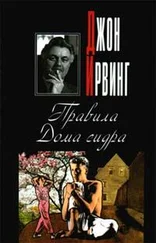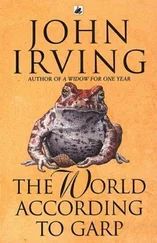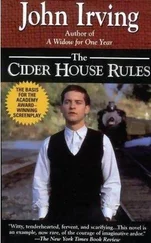I was watching Larry empty the bedpan of our friend who had this awful myelopathy; I was truly marveling at Larry—he’d become a saint—when I suddenly realized that I had no difficulty pronouncing the myelopathy word, or any of the other AIDS-associated words. (That Pneumocystis pneumonia, for example—I could actually say it. Kaposi’s sarcoma, those terrible lesions, gave me no pronunciation problem; I could say “cryptococcal meningitis” as if it meant no more to me than the common cold. I didn’t even hesitate to pronounce “cytomegalovirus”—a major cause of blindness in AIDS.)
“I should call your mother,” I told Elaine. “I seem to be having a pronunciation breakthrough.”
“It’s just because you’re distancing yourself from this disease, Billy,” Elaine said. “You’re like me—you’re imagining yourself as standing on the outside, looking in.”
“I should call your mother,” I repeated, but I knew Elaine was right.
“Let’s hear you say ‘penis,’ Billy.”
“That’s not fair, Elaine—that’s different.”
“Say it,” Elaine said.
But I knew how it would sound. It was, is, and will always be penith to me; some things never change. I didn’t try to say the penis word for Elaine. “Cock,” I said to her.
I didn’t call Mrs. Hadley about my pronunciation breakthrough, either. I was trying to distance myself from the disease—even as the epidemic was only beginning. I was already feeling guilty that I didn’t have it.
THE 1981 ATKINS CHRISTMAS card came on time that year. No generic “Season’s Greetings,” more than a month late, but an unapologetic “Merry Christmas” in December.
“Uh-oh,” Elaine said, when I showed her the Atkins family photo. “Where’s Tom?”
Atkins wasn’t in the picture. The names of the family were printed on the Christmas card in small capitals: TOM, SUE, PETER, EMILY & JACQUES ATKINS. (Jacques was the Labrador; Atkins had named the dog after Kittredge!) But Tom had missed the family photograph.
“Maybe he wasn’t feeling very photogenic,” I said to Elaine.
“His color wasn’t so hot last Christmas, was it? And he’d lost all that weight,” Elaine said.
“The ski hat was hiding his hair and his eyebrows,” I added. (There’d been no Tom Atkins review of my fourth novel, I’d noticed. I doubted that Atkins had changed his mind about Madame Bovary .)
“Shit, Billy,” Elaine said. “What do you make of the message?”
The message, which was written by hand on the back of the Christmas photo, was from the wife. There was not a lot of information in it, and it wasn’t very Christmasy.
Tom has mentioned you. He would like to see you.
Sue Atkins
“I think he’s dying—that’s what I think,” I told Elaine.
“I’ll go with you, Billy—Tom always liked me,” Elaine said.
Elaine was right—poor Tom had always adored her (and Mrs. Hadley)—and, not unlike old times, I felt braver in Elaine’s company. If Atkins was dying of AIDS, I was pretty sure his wife would already know everything about that summer twenty years ago, when Tom and I were in Europe together.
That night, I called Sue Atkins. It turned out that Tom had been placed in hospice care at his home in Short Hills, New Jersey. I’d never known what Atkins did, but his wife told me that Tom had been a CEO at a life-insurance company; he’d worked in New York City, five days a week, for more than a decade. I guessed that he’d never felt like seeing me for lunch or dinner, but I was surprised when Sue Atkins said that she’d thought her husband had been seeing me; apparently, there were nights when Tom hadn’t made it back to New Jersey in time for dinner.
“It wasn’t me he was seeing,” I told Mrs. Atkins. I mentioned that Elaine wanted to visit Tom, too—if we weren’t “intruding,” was how I’d put it.
Before I could explain who Elaine was, Sue Atkins said, “Yes, that would be all right—I’ve heard all about Elaine.” (I didn’t ask Mrs. Atkins what she’d heard about me.)
Elaine was teaching that term—grading final papers, I explained on the phone. Perhaps we could come to Short Hills on a Saturday; there wouldn’t be all the commuters on the train, I was thinking.
“The children will be home from school, but that will be fine with Tom,” Sue said. “Certainly Peter knows who you are. That trip to Europe—” Her voice just stopped. “Peter knows what’s going on, and he’s devoted to his father,” Mrs. Atkins began again. “But Emily—well, she’s younger. I’m not sure how much Emily really knows. You can’t do much to counter what your kids hear in school from the other kids—not if your kids won’t tell you what the other kids are saying.”
“I’m sorry for what you’re going through,” I told Tom’s wife.
“I always knew this might happen. Tom was candid about his past,” Sue Atkins said. “I just didn’t know he’d gone back there. And this terrible disease—” Her voice stopped again.
I was looking at the Christmas card while we spoke on the phone. I’m not good at guessing young girls’ ages. I wasn’t sure how old Emily was; I just knew she was the younger child. I was estimating that the boy, Peter Atkins, would have been fourteen or fifteen—about the same age poor Tom had been when I’d first met him and thought he was a loser who couldn’t even pronounce the time word. Atkins had told me he’d called me Bill, instead of Billy, because he noticed that Richard Abbott always called me Bill, and anyone could see how much I loved Richard.
Poor Tom had also confessed to me that he’d overheard Martha Hadley’s outburst, when I was seeing Mrs. Hadley in her office and Atkins had been waiting for his turn. “Billy, Billy—you’ve done nothing wrong !” Mrs. Hadley had cried, loud enough for Atkins to have heard her through the closed door. (It was when I’d told Martha Hadley about my crushes on other boys and men, including my slightly fading crush on Richard and my much more devastating crush on Kittredge.)
Poor Tom told me that he’d thought I was having an affair with Mrs. Hadley! “I actually believed you’d just ejaculated in her office, or something, and she was trying to assure you that you’d done nothing ‘wrong’—that’s what I thought she meant by the wrong word, Bill,” Atkins had confessed to me.
“What an idiot you are!” I’d told him; now I felt ashamed.
I asked Sue Atkins how Tom was doing—I meant those opportunistic illnesses I already knew something about, and what drugs Tom was taking. When she said he’d developed a rash from the Bactrim, I knew poor Tom was being treated for the Pneumocystis pneumonia. Since Tom was in hospice care at home, he wasn’t on a ventilator; his breathing would be harsh and aspirate—I knew that, too.
Sue Atkins also said something about how hard it was for Tom to eat. “He has trouble swallowing,” she told me. (Just telling me this made her suppress a cough, or perhaps she’d gagged; she suddenly sounded short of breath.)
“From the Candida —he can’t eat?” I asked her.
“Yes, it’s esophageal candidiasis,” Mrs. Atkins said, the terminology sounding oh-so-familiar to her. “And—this is fairly recent—there’s a Hickman catheter,” Sue explained.
“How recent is the Hickman?” I asked Mrs. Atkins.
“Oh, just the last month,” she told me. So they were feeding him through the catheter—malnutrition. (With Candida, difficulty swallowing usually responded to fluconazole or amphotericin B—unless the yeast had become resistant.)
“If they have you on a Hickman for hyperalimentation feeding, Bill, you’re probably starving,” Larry had told me.
Читать дальше












